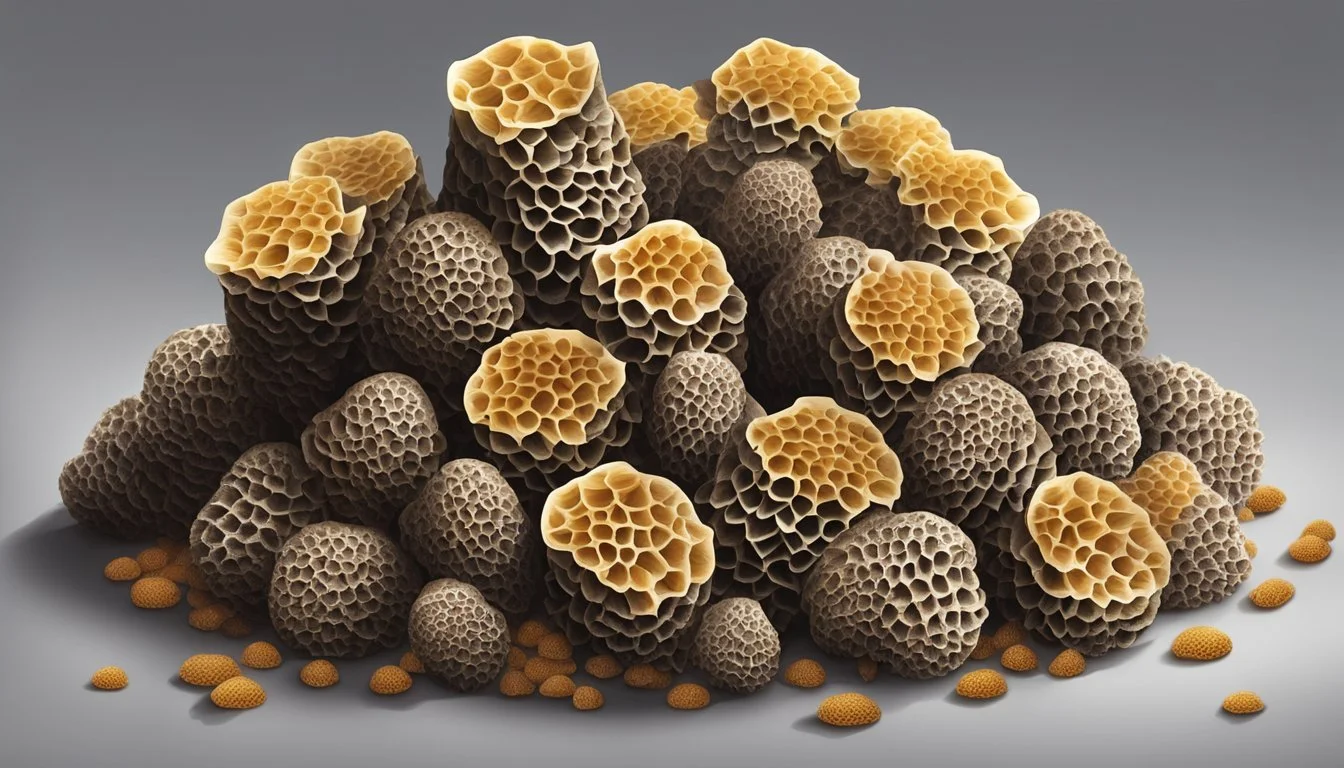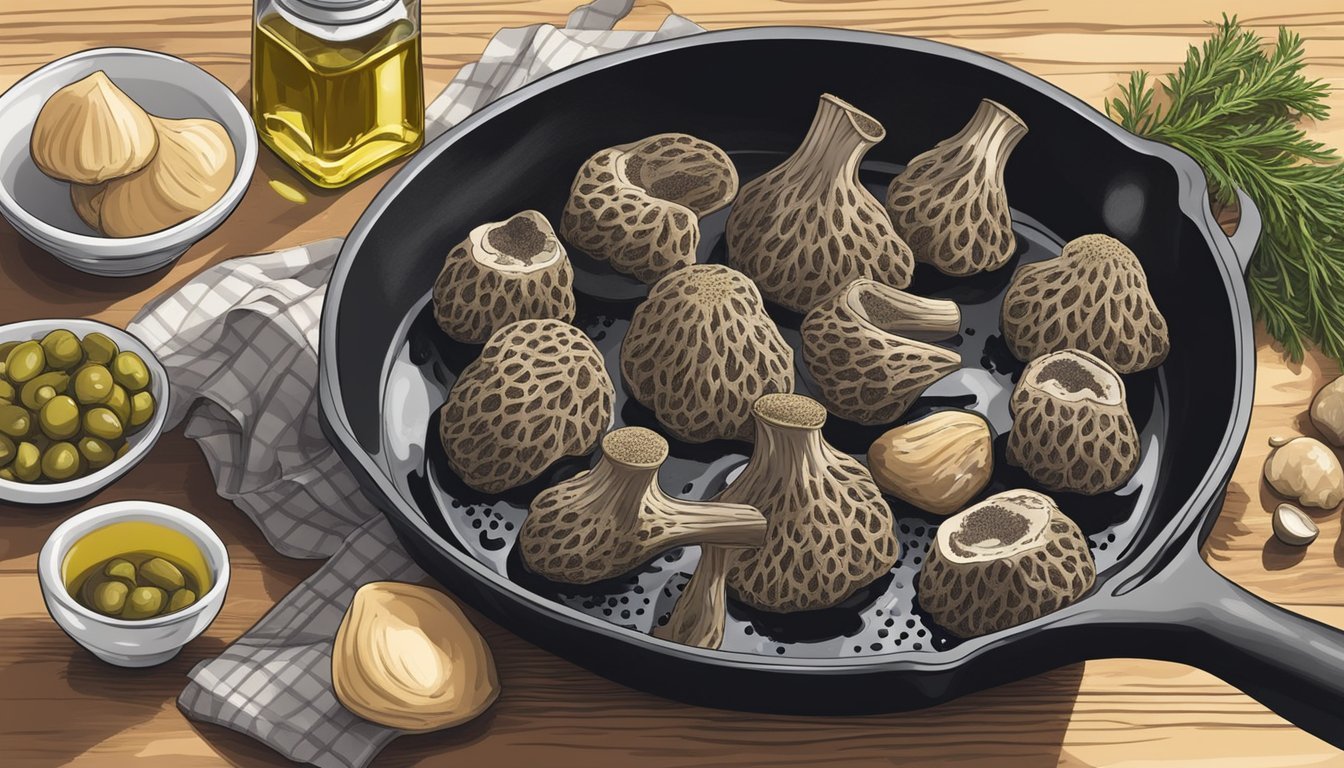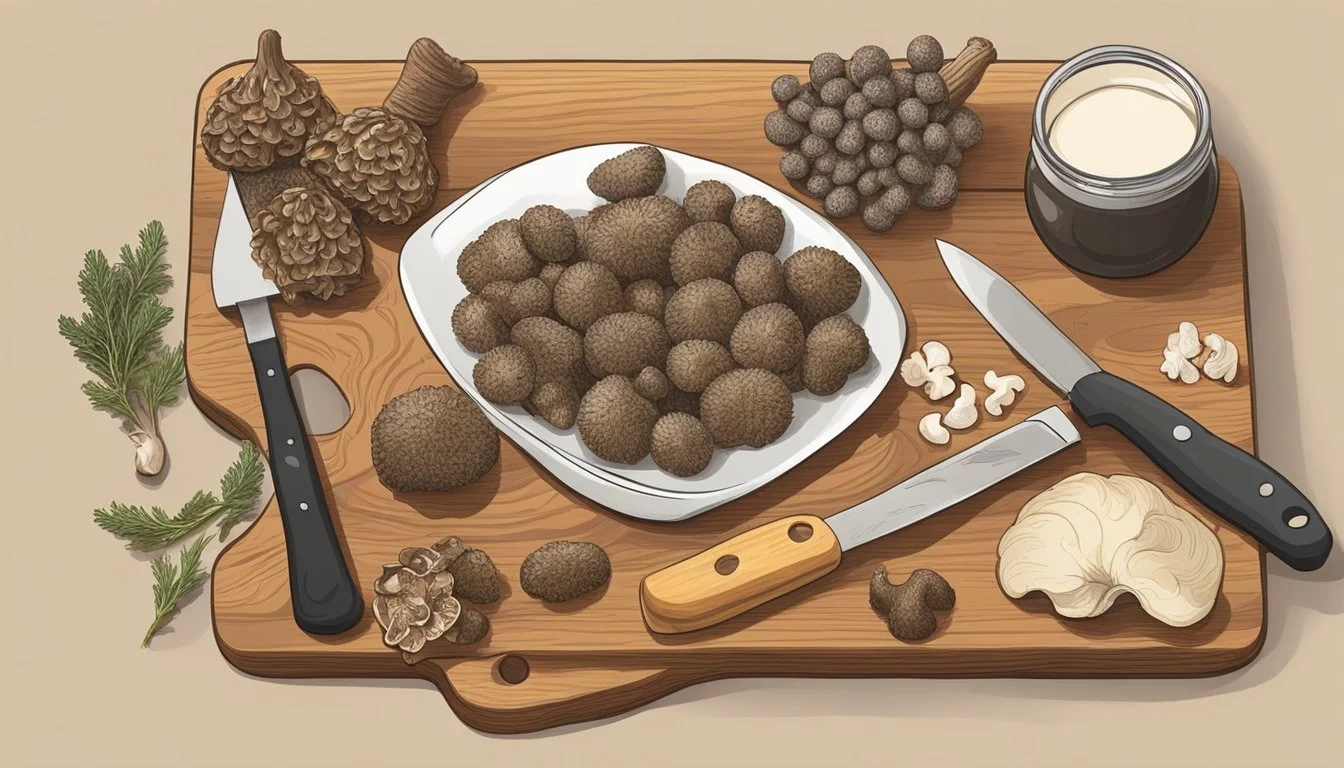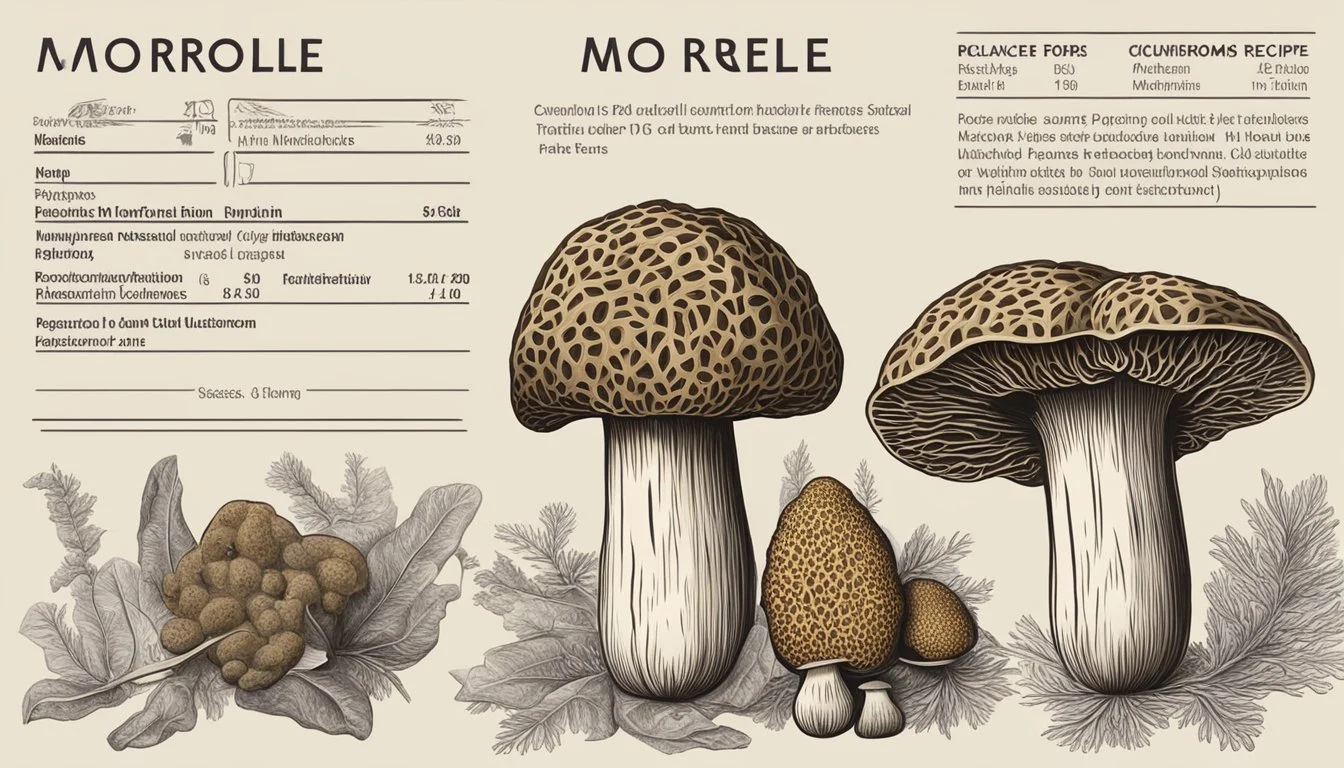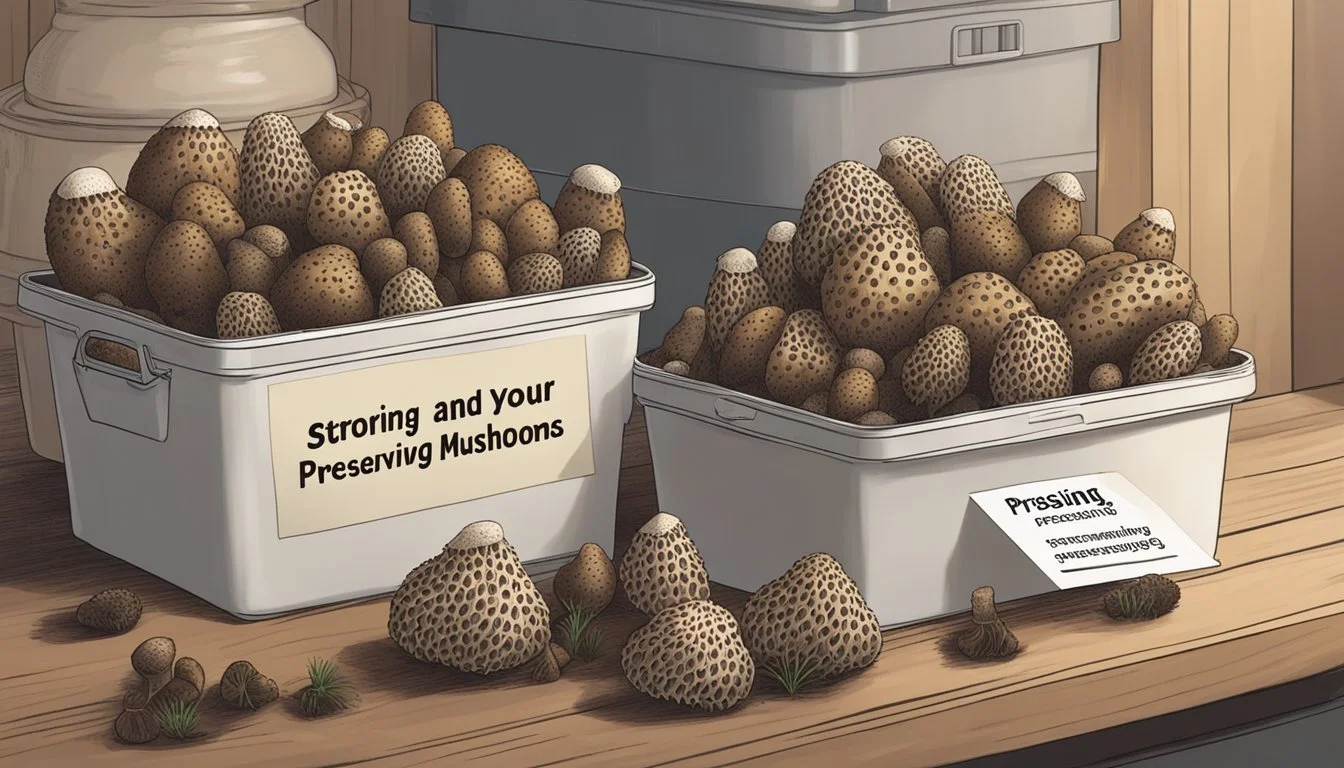How to Substitute Morel Mushrooms for Porcini Mushrooms
A Simple Guide
Morel mushrooms (What wine goes well with mushrooms?) and porcini mushrooms each bring their own unique qualities to the culinary world. Both are highly esteemed by chefs and food enthusiasts for their robust flavors and textures. Porcini mushrooms are known for their rich, earthy flavor that enhances the depth of stews (What wine goes well with stews?), risottos, and meat dishes. In comparison, morels possess a nutty and woodsy taste with a delicate texture, which intensifies when dried. They are versatile fungi that can be used in a similar array of dishes to porcini, making them an excellent substitute in recipes where porcini are traditionally used.
When substituting morel mushrooms for porcini, one should consider both the flavor profile and textural components of the dish. Morel mushrooms have a more concentrated flavor when dried, so chefs may opt to use them in their dehydrated form to better mimic the intensity of dried porcinis. Mushroom enthusiasts suggest using one and a half times the amount of dried morels to replace the porcinis, ensuring the essence of the dish remains intact.
Beyond just substituting for flavor, morel mushrooms also contribute a different mouthfeel compared to porcinis. If the recipe requires fresh porcini mushrooms, fresh morels can provide a similar meaty texture, although the moisture content and exact cooking times may need adjustment. The versatility of morel mushrooms allows them to meld seamlessly into dishes that call for the distinct taste of porcinis, confirming their suitability as a substitute in both fresh and dried forms.
Understanding Mushroom Flavors
When substituting morel mushrooms for porcini mushrooms, it’s essential to consider the distinct taste profiles each offers. Porcini mushrooms are renowned for their rich, earthy flavor and are a staple in Italian cuisine. They impart a deep, woodsy aroma with a hint of nuttiness and are a source of savory umami flavor that enhances a variety of dishes.
On the other hand, morel mushrooms are sought after for their meaty flavor, which is pronounced with a unique earthiness. Their complex taste profile includes a smoky undertone and a subtle umami character that stands out particularly in rich sauces and hearty stews.
The table below highlights the primary flavor components of both mushrooms:
Mushroom Type Flavor Attributes Porcini Earthy, woodsy, umami, nutty Morel Earthy, meaty, smoky, subtle umami
While morels have a stronger and somewhat different flavor profile compared to porcini, they can still be used effectively as a substitute in recipes. Chefs may adjust quantities to account for the more nuanced and intense flavors of morels. It is worth noting that the flavor of morels can overpower mild ingredients, so they should be used thoughtfully.
One must also consider that the texture of morels, being more ridged and spongy, lends a different mouthfeel in dishes compared to the smoother texture of porcini mushrooms. This can be an asset in creating interesting and satisfying dishes that require textural complexity.
To successfully substitute morel mushrooms for porcini mushrooms, understanding and balancing these flavor nuances is key. This ensures the integrity of the dish is maintained while introducing the delightful and distinctive taste of morels.
Morel Mushrooms: Characteristics and Culinary Uses
Morel mushrooms are a prized ingredient in gourmet cooking due to their unique characteristics and concentrated flavor. They have a delicate texture and a distinctive appearance with a honeycomb-like surface on their caps. These mushrooms are usually two to four inches long, with a hollow interior, which is one of their most distinguishable traits.
In terms of culinary uses, morel mushrooms bring a rich, nutty flavor to a variety of dishes. Their texture and taste make them adaptable in the kitchen, commonly used in:
Soups: They enrich broths with deep, earthy tones.
Sauces: Morel mushrooms can be the star of creamy sauces or a flavor enhancer in gravies.
To use morel mushrooms as a substitute for porcini mushrooms, one should take note of their potency. Morels have a stronger flavor, so it might be necessary to adjust the amounts used in recipes to avoid overwhelming the dish.
When preparing morel mushrooms, they should be cleaned with cold water and dried quickly to prevent them from absorbing too much moisture. Then, slice them to the desired size. Remember:
These mushrooms must be cooked; consuming them raw can lead to stomach discomfort.
When cooked, their complex flavor profile is best showcased in simple preparations that let their natural taste shine through.
In sum, when substituting for porcini, chefs often consider morel mushrooms for their distinct taste and texture that can elevate soups, sauces, and an array of other culinary creations.
Selecting the Best Substitute for Porcini Mushrooms
When replacing porcini mushrooms in a recipe, several other mushrooms can offer a similar flavor profile and texture. The goal is to achieve the earthy, umami quality that porcinis provide. Here are some top alternatives:
Shiitake Mushrooms: These are a commonly recommended substitute. When used fresh or dried, shiitake mushrooms contain a savory umami flavor that closely mimics that of porcini mushrooms, making them an excellent choice for most dishes.
Oyster Mushrooms: Known for their delicate texture, oyster mushrooms can be a good alternative to porcini mushrooms. They work particularly well in recipes where the mushrooms are sautéed and served with lighter sauces.
Cremini Mushrooms: These are the more mature form of button mushrooms and are similar in flavor to porcinis but milder. Cremini mushrooms are versatile and can be used in a variety of recipes where a meaty texture is desired.
Button Mushrooms: Available and affordable, button mushrooms can serve as a substitute, although they are less flavorful. They are best used in recipes with other strong flavors.
When selecting a substitute for porcini mushrooms, consider the cooking method and the role of the mushroom in the dish. Some mushrooms, like shiitakes, have a stronger flavor and are better suited for recipes where mushrooms are the centerpiece. Oyster and cremini mushrooms, with their more delicate flavors, are better in dishes with a variety of ingredients.
Table of Porcini Mushroom Substitutes:
Substitute Flavor Profile Best Used In Shiitake Mushrooms Rich, umami Soups, stir-fries Oyster Mushrooms Subtle, sweet Light sauces, sautéed Cremini Mushrooms Mild, earthy Stews, sauces Button Mushrooms Less pronounced Any dish with strong flavors
Always remember to adjust the cooking times according to the substitute chosen, as some mushrooms require less or more time than porcinis to cook fully.
How to Prepare Morel Mushrooms as a Porcini Substitute
Morel mushrooms, with their earthy and nutty flavor profile, can be a suitable substitute for porcini mushrooms in a variety of dishes. Proper preparation is essential to ensure that they provide a comparable taste and texture.
Soaking and Rinsing
Dried morels should be rehydrated before cooking to mimic the texture of porcini mushrooms. Here's a step-by-step guide:
Soak the dried morels in warm water for at least 30 minutes.
Rinse the mushrooms multiple times to remove any residual dirt or debris.
Gently squeeze the morels to drain excess water.
This process not only cleans the morels but also helps to concentrate their robust, earthy flavor, which is why they are favored as a substitute.
Seasoning Adjustments
The natural flavor of morels is similar to porcini mushrooms, but a few adjustments can create a closer match:
Add a pinch of dried thyme to the morels to enhance their earthiness.
Use salt sparingly, as morels will absorb and amplify the flavor.
Adjust seasonings gradually, always tasting as the morels can quickly absorb added flavors, which may result in an intense taste if over-seasoned.
Cooking Techniques
Morel mushrooms can replace porcini mushrooms seamlessly if cooked appropriately:
Sauté the rehydrated morels in a bit of oil or butter until they develop a golden-brown color.
When simmering in soups or stews, add the morels towards the end of the cooking time to prevent them from becoming too soft.
For pasta or risotto dishes, cook the mushrooms separately and incorporate them just before serving to maintain their distinct flavor.
These methods will ensure that the morels contribute not only a similar texture but also a complementary flavor to the dish they are used in, successfully standing in for porcini mushrooms.
Adjusting Recipes for Different Mushroom Types
When substituting morel mushrooms for porcini in recipes, the chef must consider the texture, moisture content, and flavor profile to achieve a comparable taste and consistency.
Soups and Stews
In soups and stews, porcini mushrooms impart a robust earthy flavor and maintain their texture well during the slow cooking process. Morels, although lighter in texture, can equally contribute an intense umami flavor. For every cup of porcini mushrooms, one may use a cup of morels. However, morels should be added later in the cooking process to prevent them from becoming too soft.
Earthy flavor: Utilize the intense umami of morels to match the earthiness of porcinis.
Liquid Content: Adjust the liquid in the recipe as morels may release more moisture during cooking.
Sauces and Risottos
Porcini mushrooms are often used in creamy sauces and risottos for their strong flavor and firm texture. When using morels as a substitute, it's essential to finely chop them, as their larger, sponge-like structure can alter the desired final texture of these dishes.
Risottos: Add chopped morels into the dish at the same stage you would add porcinis to impart a comparable savory taste.
Creamy Sauces: Incorporate finely chopped morels to ensure a smooth sauce, adjusting the seasoning to account for their slightly smokier notes.
Stir-fries and Sautés
Morels can easily stand in for porcini mushrooms in stir-fries and sautés due to their similar cooking times when sliced. They should be added to the pan or wok after the base ingredients, allowing their delicate texture to be preserved and their subtle flavors to be released without overpowering the dish.
Cooking Time: Sauté morels for a shorter duration than porcinis to avoid overcooking.
Flavor Profile: Take advantage of morels' unique flavor by pairing them with ingredients that complement their lighter woodsy notes.
Additional Mushroom Substitutions
When substituting morel mushrooms for porcini, it's essential to consider the flavor profiles and textures of the alternatives. The following are specific options and their culinary uses.
Using Shiitake Mushrooms
Shiitake mushrooms are a robust alternative, known for their rich, umami flavor which closely resembles that of porcini mushrooms. These mushrooms work well in:
Soups and broths: Shiitake adds depth with its meaty essence.
Sauces: Ground or finely chopped, they enrich gravies and pasta sauces.
Shiitake Mushroom Substitutes:
Fresh chanterelle mushrooms, offering a similarly rich taste.
Dried shiitake, which requires rehydration, provides concentrated flavor.
Oyster Mushroom Varieties
Oyster mushrooms offer a milder taste with a hint of sweetness and a soft, tender texture. They are versatile and can be used in:
Stews and stir-fries: Their delicate texture complements these dishes well.
Vegetarian recipes: A great stand-in for meaty textures.
King oyster mushrooms, which are larger and have a meatier texture.
Other mushroom varieties such as chanterelle, depending on availability and desired flavor.
Utilizing Cremini and Button Mushrooms
Cremini mushrooms are young portobello mushrooms, and along with white button mushrooms, are milder substitutes. They are best used where a subtle, earthy flavor is needed, such as in:
Sautés and salads: Their subtle flavors won't overpower the dish.
Everyday cooking: They are readily available and provide a similar texture to morels when cooked.
Portobello mushrooms, which are essentially mature cremini with a deeper flavor.
White button mushrooms offer a similar mild taste and texture.
Flavor Enhancements and Complementary Ingredients
When substituting morel mushrooms for porcini in recipes, it’s essential to balance the distinct nutty and earthy flavors of morels with the right herbs, spices, and ingredients. These enhancements should complement the mushrooms' naturally rich taste and contribute to the overall savoriness of the dish.
Herbs and Spices
Thyme: A classic herb, thyme pairs wonderfully with morel mushrooms, enhancing their woodsy flavor without overwhelming.
Garlic: Adding garlic brings a robust aroma that melds nicely with the subtle smokiness of morels.
Cumin: Should be used sparingly; its warm and earthy taste can accentuate the morels' flavors without dominating.
Vegetable Accents
Tomato Paste: A small amount can add depth to the dish, lending a background tanginess that bridges the flavors of morel mushrooms and other vegetables.
Garlic: Its pungent flavor serves not only as a spice but also as a vegetable accent that can be sautéed with morels to create a rich foundation.
Enhancing Umami
Soy Sauce: A dash can intensify the umami character of morel mushrooms, enriching the overall taste profile. Use sparingly to avoid overshadowing the morels.
Tomato Paste: Its concentrated savory notes further bolster the umami when combined with morels.
Health Benefits and Nutritional Considerations
When opting to use morel mushrooms in place of porcini, health benefits and nutritional content are worth noting.
Morel Mushrooms: Morel mushrooms are acclaimed for their nutrition. They are a source of vitamins and minerals, with a 100-gram serving providing more than half of the daily recommended value for iron and a significant amount of vitamin D. Notably, they contain antioxidants which can help combat oxidative stress, though the exact types and amounts differ between morel and porcini mushrooms.
Nutritional Breakdown:
Nutrient Morel Mushrooms (per 100g) Calories 31 kcal Iron 12.2 mg Vitamin D 206 IU
In contrast, porcini mushrooms offer their own unique nutritional profile, with differences in vitamin and mineral concentrations.
Umami Flavor: Both morels and porcinis contribute a rich umami flavor to dishes, a savory taste that is deeply appreciated in gastronomy. This taste is due to the natural glutamates in the mushrooms, which is why they serve well as substitutes for each other in recipes while presenting their unique flavors.
Considering nutritional content and health benefits is vital when substituting morels for porcinis. Such substitutes should be made thoughtfully, bearing in mind the impact on the desired flavor profile and nutritional outcomes of the dish.
Storing and Preserving Your Mushrooms
Proper storage and preservation techniques are critical for maintaining the quality and flavor of mushrooms, especially when substituting morels for porcini. Mushrooms can be kept in peak condition through methods like drying and freezing.
Drying and Dehydrating
Drying mushrooms is an excellent way to preserve their flavor and extend their shelf life. Both morels and porcini can be dehydrated successfully. For the best results:
Clean the mushrooms by gently brushing off any dirt.
Slice the mushrooms into uniform pieces to ensure even drying.
Arrange the slices on a baking sheet or a dehydrator tray in a single layer.
Dehydrate at a low temperature until completely dry. This usually takes between 6 to 12 hours depending on the method and mushroom type.
Once dry, store them in an airtight container in a cool, dark place. They should last for several months and can easily rehydrate when needed.
Freezing Techniques
For freezing, mushrooms should be prepped properly to retain their texture and taste. Here are the steps for an effective freeze:
Blanch the mushrooms in boiling water for 2-3 minutes — this helps to preserve their color and flavor.
Chill them quickly in ice-cold water to stop the cooking process.
Drain well and pat the mushrooms dry with a clean towel or paper towel.
Package the mushrooms in freezer-safe bags or containers. Remove as much air as possible before sealing.
Frozen mushrooms can keep for up to 6 months. When ready to use, cook them directly from frozen — no thawing required.
Remember, these techniques are also applicable for other mushroom varieties, such as dried shiitake or chanterelles, making them versatile methods for any mushroom substitution.



